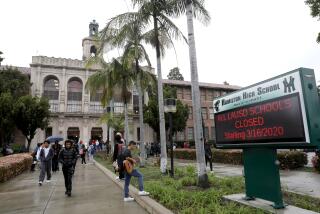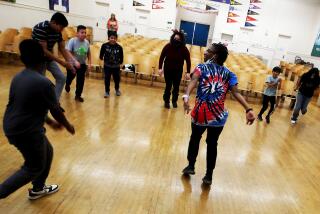Stop L.A. Unified’s ‘charterization’
As The Times continues to lead the parade to charterization of the Los Angeles Unified School District, one of the most overused and misunderstood phrases on the paper’s editorial page is “reform.” Change is not necessarily reform. Genuine reform produces lasting, beneficial improvements and isn’t concocted by editors or frustrated school boards willing to try just about anything.
That was never more evident than during the debate over the current plan to allow outsiders to operate dozens of LAUSD campuses. As The Times notes in its Feb. 1 editorial, “Bidding to run L.A.’s schools,” the district’s mislabeled Public School Choice initiative has resulted in ugly misinformation campaigns and popularity contests over which organizations should run several L.A. Unified schools. Change, yes; reform, hardly.
Privatizing public education is but one of many elixirs offered over the years as panaceas for whatever ails California’s schools. One fad after another has been foisted on children, their parents and teachers by supposed do-gooders, many of whom really wanted to promote a particular ideology or seek financial gain.
The once tried but eventually discarded fads include “new math,” single-sex classrooms and the nearly forgotten 6-4-4 plan, under which students spent the final two years of high school on a junior college campus. Other reforms tried over the last century include the look-say approach to reading and integrated English and social studies classes. Today we have vouchers, charters, the No Child Left Behind Act and the Obama administration’s misnamed Race to the Top fund.
Some “reforms” have been reinvented through the generations. Bilingual education was a problem some 160 years ago when English-speaking Americans moving to Los Angeles overwhelmed the existing schools -- in which the language of instruction was Spanish. Modern reformers have attempted to solve the problem of multilingual classrooms by immersion, sheltered instruction, the use of a native language to teach basic subjects and so on. The method varies with the political mood of the day.
One of the genuine reforms, championed by early 20th century progressives, was vocational education. A 1901 Times editorial called for the establishment of a polytechnic high school in Los Angeles emphasizing manual training. Such instruction was not part of the traditional curriculum, as teaching young people a trade had been the responsibility of the home, craft guilds and unions or private businesses.
Times Publisher Harrison Gray Otis was no progressive, but as a businessman he realized the need for high school graduates trained in occupations that an industrial society needed. When such a school, Manual Arts High, opened in 1910, The Times was ecstatic.
Now, ironically, vocational education doesn’t have a place at Manual Arts, an L.A. Unified school operated by a nonprofit organization. At Locke High School in L.A., a campus operated by charter school organization Green Dot, everyone must take a college-bound curriculum. Both schools are at the forefront of the “everyone goes to college” movement.
The possibility of economic improvement appeals to parents and students who desperately want to escape the circumstances they’re in. But assigning unprepared and disinterested students to a University of California or California State University curriculum is a disservice to them. Furthermore, the wisdom of offering vocational training is demonstrated by high enrollments at Los Angeles Trade-Technical College, DeVry and similar institutions. Even Mayor Antonio Villaraigosa now supports expanding vocational education classes at public schools.
It won’t be long before the folly of today’s experiment of putting control of schools up to bid is seen by another set of editors and school board members who will have to undo the damage done by today’s “reformers.” Unfortunately, legal and financial barriers will keep the schools in the hands of entrepreneurs long after the public, Times editors and school board members realize that this “reform” was more detrimental to our children than any of the failed experiments of the past.
Gloria R. Lothrop and Ralph E. Shaffer are, respectively, professors emeritus of history at Cal State Northridge and Cal Poly Pomona.
More to Read
A cure for the common opinion
Get thought-provoking perspectives with our weekly newsletter.
You may occasionally receive promotional content from the Los Angeles Times.










